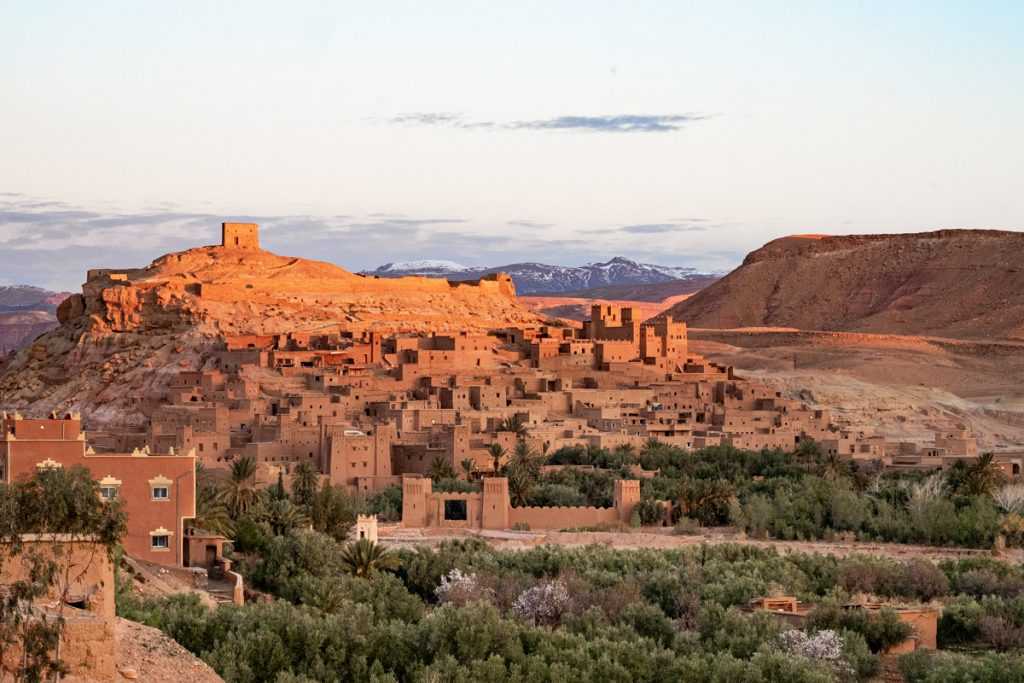There's a reason why so many directors have come to shoot films here. It is a place that transports you through time and space, leaving you with beautiful memories.

Ksar Ait Benhaddou is located in the High Atlas’s first southern foothills. It is made up of buildings that demonstrate earthen construction techniques used in the presaharan regions. The earthen houses found at Ksar Ait Ben Haddou perfectly represent a whole generation of ksours built in the valleys of Drâa, Todgha, Dadès, Mgoun, Ziz, and Souss in the early 16th century. Despite the fact that their structure and technique have been known in the valleys of southern Morocco for a very long time, the oldest constructions do not predate the 17th century.
Widely used in posters, advertisements, and phone cards, Ait Benhadou is an important southeastern heritage that promotes authentic Morocco.
Ksar Ait Ben Haddou was and still a source of inspiration for historians, sociologists, and architects. According to legend, a granary on the highest peak, have witnessed the very first human occupation, long before the Ksar was built. Another story says that an Amazigh princess have ruled the region long before Islam arrival. The ksar was also one of many stops on the trade route that connected the old Sudan (Gao, Timbuktu, Djenné, and so on) to Marrakech via the Draa Valley and the Tizi N’Telouet pass. Regardless of the stories told, the Ksar is a source of fascination for its visitors.
According to historians, this Ksar dates back to the 17th century but its name references Amghar Benhaddou, the first governor, who lived there during the Almoravid period (11th century). His name was later attached to it. Hassan the First, the sultan of the Alaouite dynasty, was the first to pass through Ksar Ait Ben Haddou on his way to Marrakech by Telouet during his last military expedition (1893-1894).
UNESCO’s World Heritage
The fact that Ksar Ait Benhaddou’s construction materials are still earth and wood makes it very interesting. Added to the UNESCO World Heritage List in 1987, it holds its architectural authenticity in terms of forms and materials. The large houses at the bottom of the village, with preserved decorative motifs, are also in a good condition. The houses in the Ksar are built in the shape of a small, closed, and suspended grouping. There are a few families who still live there, and some of them enjoy showing tourists around their homes. A mosque, a public square, cereal threshing floors outside, a caravanserai, two cemeteries for Muslim and Jewish, and the sanctuary of the saint Sidi Ali ou Amer are among the Ksar’s public spaces.
A collective ruined granary was built above Kasbah Ait Benhaddou around a central distribution space in order to regulate the layout of presaharian villages and order the grouping of Kasbahs.
If you climb the heights overlooking of the Ksar in the late afternoon, you can see the stunning scenery of the surrounding palm grove. You’ll be able to see even the tiniest architectural detail reflected by the sun.
preserving and promoting history of cinema
Being one of the Atlas region’s most exotic and well-preserved Kasbahs, Lawrence of Arabia (1963), Jesus of Nazareth (1977), The Mummy (1999), Gladiator (2000), Prince of Persia (2010), Game of Thrones Season 3 (2013), and many other movies were shot in Ait Benhaddou.
Several movies were shot here, and Ksar Ait Ben Haddou has been able to preserve its architectural authenticity by ensuring its reconstruction and carrying out the required restorations, which are still ongoing.
Moussem Aït Ben Haddou
On the right bank of the river El Maleh, some of the residents who left the old Ksar in the 1960s have settled in a new near village. They hold an annual regional fair honoring the saint Sidi Ali ou Amer every second Saturday in June of the Amazigh agricultural calendar. The Ait Ben Haddous’ and the residents of neighboring towns attend this moussem.
The elegance of the view surrounding the Ksar, the reddish color of its facades and crenellated walls, the azure blue of the water, and the tender green of the vegetable gardens have inspired many artistes including the French painter Jacques Majorelle, who immortalized Ksar Ait Benhaddou in his work. In his famous paintings, Majorelle was one of the first to portray the still unknown territories of deep Morocco. During his visits, Majorelle might have developed new painting techniques in front of Ksar Ait Ben Haddou, including the mixed gold and silver with pigments to enhance the original patterns and lights. He was the one who created the Majorelle blue color, named after him. His paintings are exhibited in Marrakech’s “Berber Museum” in the villa “Jardin Majorelle.”